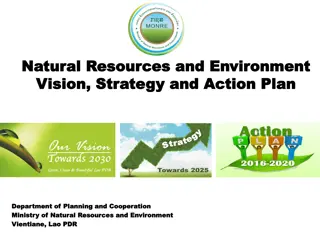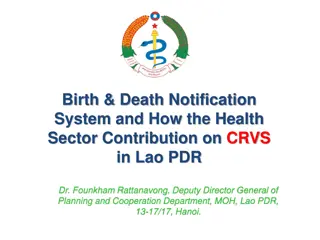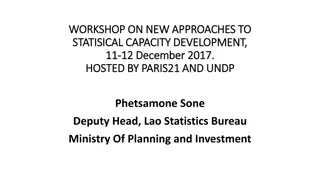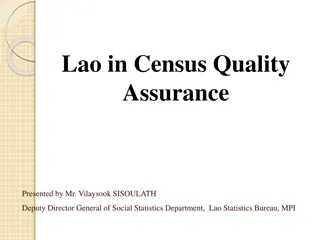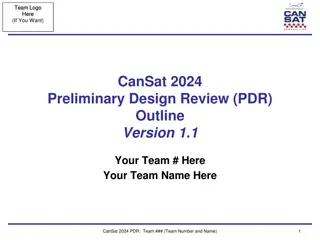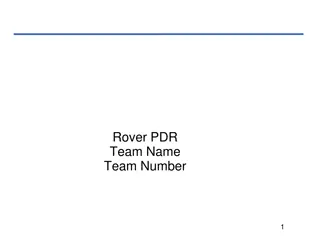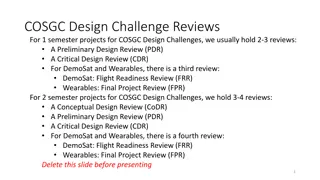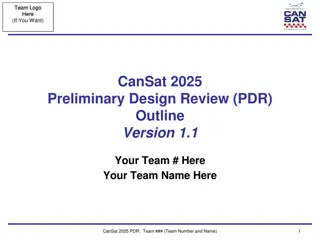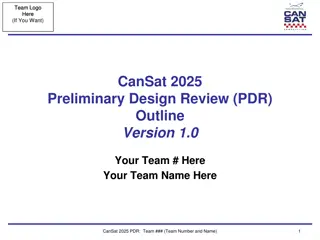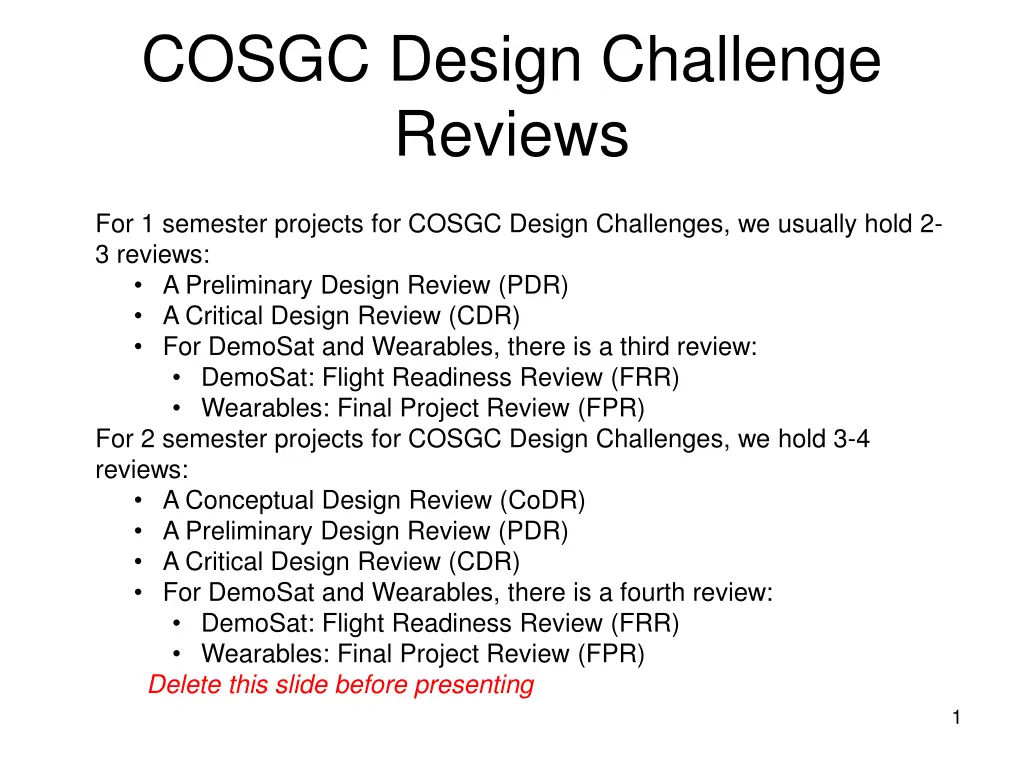
COSGC Design Challenge Reviews Overview
Learn about the review process for COSGC Design Challenges, including different types of reviews like Preliminary Design Review and Critical Design Review. Understand the requirements for each review stage and the importance of meeting project goals and budget constraints.
Download Presentation

Please find below an Image/Link to download the presentation.
The content on the website is provided AS IS for your information and personal use only. It may not be sold, licensed, or shared on other websites without obtaining consent from the author. If you encounter any issues during the download, it is possible that the publisher has removed the file from their server.
You are allowed to download the files provided on this website for personal or commercial use, subject to the condition that they are used lawfully. All files are the property of their respective owners.
The content on the website is provided AS IS for your information and personal use only. It may not be sold, licensed, or shared on other websites without obtaining consent from the author.
E N D
Presentation Transcript
COSGC Design Challenge Reviews For 1 semester projects for COSGC Design Challenges, we usually hold 2- 3 reviews: A Preliminary Design Review (PDR) A Critical Design Review (CDR) For DemoSat and Wearables, there is a third review: DemoSat: Flight Readiness Review (FRR) Wearables: Final Project Review (FPR) For 2 semester projects for COSGC Design Challenges, we hold 3-4 reviews: A Conceptual Design Review (CoDR) A Preliminary Design Review (PDR) A Critical Design Review (CDR) For DemoSat and Wearables, there is a fourth review: DemoSat: Flight Readiness Review (FRR) Wearables: Final Project Review (FPR) Delete this slide before presenting 1
TEMPLATE NOTES Each type of review requires somewhat different information, so each has its own template You can reformat the template to fit your design, but be sure to cover at least the information requested in each review template This template includes a lot of things. If you have difficulty with concepts, or don t think you have time to include something, just let us know! A good approach to creating effective slides is to use pictures and/or graphs but fewer words. Don t just read slides. Practice as a team, talking through each slide. Reviewers should hear the voices of every team member. Delete this slide before presenting 2
TEMPLATE NOTES The Conceptual Design Review (CoDR) should: Explain the concept of your Project Define preliminary Goals Present Concept of Operations Delete this slide before presenting 3
References This template asks for a few things that might be new to you (e.g. ConOps, etc.) Here are a few places to start learning about them. Project Goals ConOps Examples of ConOps Software Flow Chart Functional Block Diagram (FBD) Delete this slide before presenting 4
TEMPLATE NOTES The purpose of the CoDR is to verify that: The project goals are well-defined and understood Verify that the Concept of Operations provides for meeting all project goals The proposed design meets time and monetary budget available Delete this slide before presenting 5
Later Reviews Preliminary Design Review (PDR): Have obtained and tested subsystems (e.g. individual sensors, motors ) Critical Design Review (CDR): Subsystems are integrated and working together For DemoSat: Launch Readiness Review : Is your payload fully integrated and tested? Have all safety and other flight requirements been met? 6
User notes: You may reformat this to fit your design, but make sure you cover the information requested in this template. This template is the barebones of what is needed. Presentations should be emailed in either .ppt, .pptx, or .pdf format to bgarcia@colorado.edu at least 24 hours prior to your scheduled review. You have up to 45 minutes to present you need to cover a lot of material in a short amount of time, so be concise! Practice your presentation. Make sure all team members have a chance to talk. Don t read your slides word-for-word.
Team Name Conceptual Design Review *Replace this text with a picture relevant to your project* Institution Team Members COSGC Robotics/Wearables Challenge (choose correct challenge) Date 8
Project Overview Name of Presenter(s) 9
Mission Overview (spend a lot of time here-Multiple Slides) What is your objective? What do you expect to prove, discover, or learn from your experiment? (what problem are you addressing) Brief overview of underlying science/theory What other related research/experimentation has been done in the past? Results? Mission Requirements Given the technical difficulties of the project, what components will your wearable need to have to be successful?
Subsystem Requirements (Multiple Slides) -What subsystems do you have: power, C&DH, thermal, etc. -What requirements do you have for each subsystem. -What requirements do each subsystem impose on each other. - You should have quantifiable requirements in this section. - Power subsystem shall supply 2W to - Power subsystem shall remain at or above 72 F at all times during the flight. -Which requirements are design drivers?
Block Diagrams (Multiple Slides) -Block Diagrams of each of the major subsystems shall be included. - Use these as visual cues to explain the connections between subsystems - Don t skimp on details if there is a power switch or a g-switch, make sure that it is included -This is where you explain the design of your system and how it operates.
Special Requirements (Multiple Slides) - Some experiments have very special needs that shall be addressed in detail - Schematics (???) - Mechanical Drawings - Demonstrated Need
Schematic/Drawings/Analysis (Multiple Slides) - This section is reserved for electrical schematic and mechanical drawings. - These show the reviewers that you have taken the design to the next level and understand the physical dimensions of the system as well as the electrical characteristics Any analysis that has been completed so far shall also be contained in this section. - Computer models - Any component tests or research that may have been completed - - !! Schematics/Drawings/Analysis and Block diagrams are the driving elements of a PDR. Prove to the reviewers that your design is established enough that you can start bench testing and ordering test/development hardware !!
Commands and Sensors (Multiple Slides) -This section contains charts that show the flow of data and commands. - What states can your payload be in? - Active, Active/Safe, Idle etc. -The key items that we are looking for are data flow diagrams and budgets - Memory budgets - How many samples, how long, do you have enough memory? - Where is data stored? - How does the data get there? - What commands queue data acquisition? -General software flow chart for main code -Be sure to include sensor specifications - Will they meet your need?
Test Plans (Multiple Slides) - - What type of testing can be performed on your systems? What is required to complete testing?: - Support Hardware - Purchase/produce? - Software - Purchase/in-house? Potential points of failure Testing/Troubleshooting/Modifications/Re-Testing Schedule - -
Parts List (Multiple Slides) -MAJOR Components lists - Not at the nut and bolt level just major hardware that will be purchased or built in house - Lead times (This can make or break a project) - Distributors - Manufacturers - Cost (Don t forget to consider shipping and tax)
Management Updated Organizational Chart Updated Budget Updated Schedule For your schedule, keep in mind reviews, video creation and submission (Symposium).
Conclusion Issues and concerns Closing remarks





